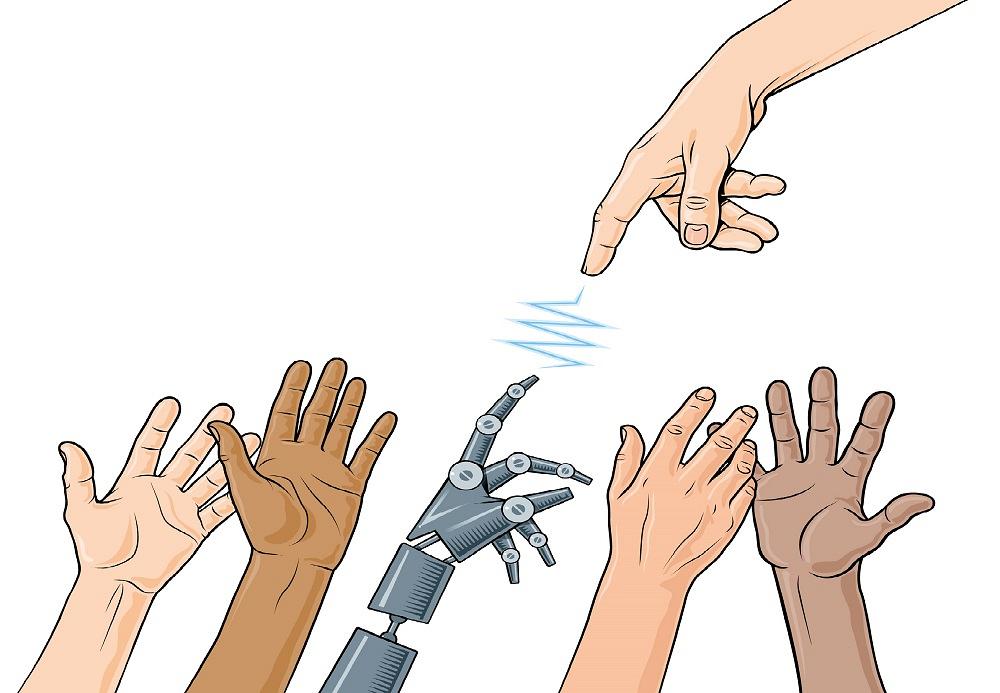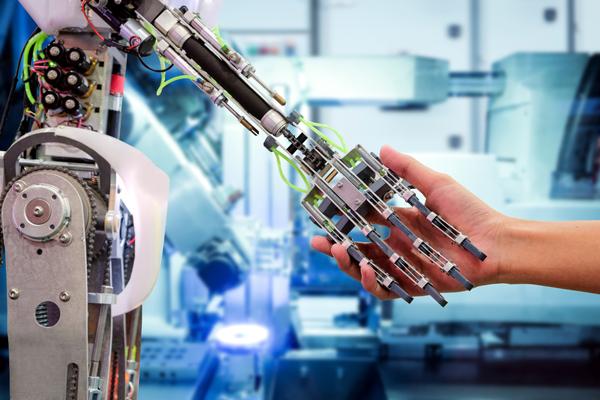Senior Editor
- FMA
- The Fabricator
- FABTECH
- Canadian Metalworking
Categories
- Additive Manufacturing
- Aluminum Welding
- Arc Welding
- Assembly and Joining
- Automation and Robotics
- Bending and Forming
- Consumables
- Cutting and Weld Prep
- Electric Vehicles
- En Español
- Finishing
- Hydroforming
- Laser Cutting
- Laser Welding
- Machining
- Manufacturing Software
- Materials Handling
- Metals/Materials
- Oxyfuel Cutting
- Plasma Cutting
- Power Tools
- Punching and Other Holemaking
- Roll Forming
- Safety
- Sawing
- Shearing
- Shop Management
- Testing and Measuring
- Tube and Pipe Fabrication
- Tube and Pipe Production
- Waterjet Cutting
Industry Directory
Webcasts
Podcasts
FAB 40
Advertise
Subscribe
Account Login
Search
How automation spurs manufacturing economic development
Manufacturers with more advanced skills and higher wages help communities grow
- By Tim Heston
- September 8, 2019
- Article
- Automation and Robotics

Automation doesn’t solve every manufacturer’s problem; it’s just a tool. But in many instances, it’s an increasingly important tool that has implications on and off the plant floor. Getty Images
Consider this hypothetical tale of two large OEM plants. Both have been economic engines of their respective communities for years. Several decades ago each plant employed about a thousand people, many of whom made a decent wage.
Everyone made enough money to support local retailers, buy homes, pay for home maintenance, and more. And they made enough to form a decent tax base, too, and good public schools. It was manufacturing’s multiplier effect at its best.
Then manufacturing changed. At both plants, the simplest, highest-volume work went overseas. Product mixes broadened, and with them came new inventory strategies and different demand cycles.
Here’s where the two plants took different paths. Managers at one plant thought their product lines were too disparate for automation.
During periods of peak demand, employees and temps worked furiously, inserting bolt after bolt, weld after weld, hauling boxes and packing material as fast as they could. The quality problems were there—no surprise in a plant full of temp workers, many of whom quit after a few days or weeks on the job. But supervisors trained new temp workers as best as they could and muscled through to maintain throughput.
Outside the plant walls, things began to change. Mom-and-pop retailers shuttered, dollar stores moved in, and with a shrinking tax base, the local schools started falling apart. Many weren’t making a high wage, and even if they were, they probably weren’t employed year-round, and they didn’t enjoy the health care and other benefits of steady full-time work.
Then came the terrible news: The company’s corporate parent initiated a restructuring, changing product lines and selling or shuttering plants that produced unprofitable products. Unable to find a buyer, the local plant closed, and things went from bad to worse. The town’s population shrank, local schools closed, and those who remained sent their children to schools an hour or more away.
The community is a shadow of its former self. It’s the multiplier effect in reverse.
The community around the other plant looks different. While changed, the area isn’t struggling. The parking lot isn’t as full as it once was, but the cars look reliable and well-maintained. The town’s main-street businesses are holding their own against the retail chains in the shopping centers by the interstate exit a few miles away.
In this case, manufacturing’s ripple effect is still there—it hasn’t shifted into reverse—but it’s different, made evident by several new industrial parks in the area full of specialty manufacturers and suppliers like a new custom metal fabricator, a machine shop, a plastic injection molding operation, even an outfit that supports controls for robots and similar automation. Collectively, these places don’t employ thousands, yet there remains a steady stream of trucks full of products driving in and out of them.

Employees on an advanced manufacturing floor will require training, but as their skills increase, so does their value. Getty Images
You then walk into the OEM plant, and it looks nothing like it did. Like the other OEM plant, it too now must deal with widely varying product lines and demand cycles. But unlike the other plant, it focuses on ways to make employees more productive in the concrete sense—that is, more sales dollars (minus material costs) per employee—and their increased wages reflect that.
Assemblers now work alongside robots and cobots. Heavy pieces are transported automatically or with lift-assists. Artificial intelligence helps systems of all kinds—from the laser cutting machine in the fabrication shop to the pick-and-place robot in the middle of final assembly—learn, adapt, and perform better over time.
The plant doesn’t avoid temps entirely, but you won’t see a lot of them. Temps without the right skills couldn’t handle most jobs anyway. Most important, when sales patterns change and corporate strategies shift, the plant is so productive that the corporation’s top brass wouldn’t think of shuttering it. The plant receives new product lines regularly and adapts and retools to suit.
It isn’t a panacea. In a manual operation reliant on temp workers, if a temp worker doesn’t come to work, someone else can be called to fill in. Not so with an automated line. What if a robot maintenance tech doesn’t show up to work, and the line crashes? (In Alabama, such an incident spurred the development of the Alabama Robotics Technology Park, a state-taxpayer-funded training center.)
Automation doesn’t solve every manufacturer’s problem; it’s just a tool. But in many instances it’s an increasingly important tool that has implications on and off the plant floor.
The chase toward cheap labor has given manufacturing a bad reputation, some would say deservedly so, considering the life of those in towns with mothballed manufacturing plants. Manufacturers do need to reduce costs, including labor costs; it’s the nature of capitalism. But in many cases, a plant full of automation can hire fewer workers, lowering labor costs but also paying each worker more. They do need training (a problem that facilities like the Alabama RTP aims to solve), but as their skills increase, so does their value.
Does everyone, even those with the right skills and qualifications, receive higher wages? Of course not—a fact not forgotten by lawmakers pointing fingers at executives trying to meet next quarter’s numbers (then tone down the rhetoric as the political donations roll in). Still, no one would argue that to achieve truly sustainable economic development, higher skill and wages need to be part of the equation.
About the Author

Tim Heston
2135 Point Blvd
Elgin, IL 60123
815-381-1314
Tim Heston, The Fabricator's senior editor, has covered the metal fabrication industry since 1998, starting his career at the American Welding Society's Welding Journal. Since then he has covered the full range of metal fabrication processes, from stamping, bending, and cutting to grinding and polishing. He joined The Fabricator's staff in October 2007.
subscribe now

The Fabricator is North America's leading magazine for the metal forming and fabricating industry. The magazine delivers the news, technical articles, and case histories that enable fabricators to do their jobs more efficiently. The Fabricator has served the industry since 1970.
start your free subscription- Stay connected from anywhere

Easily access valuable industry resources now with full access to the digital edition of The Fabricator.

Easily access valuable industry resources now with full access to the digital edition of The Welder.

Easily access valuable industry resources now with full access to the digital edition of The Tube and Pipe Journal.
- Podcasting
- Podcast:
- The Fabricator Podcast
- Published:
- 04/16/2024
- Running Time:
- 63:29
In this episode of The Fabricator Podcast, Caleb Chamberlain, co-founder and CEO of OSH Cut, discusses his company’s...
- Trending Articles
AI, machine learning, and the future of metal fabrication

Employee ownership: The best way to ensure engagement

Dynamic Metal blossoms with each passing year

Steel industry reacts to Nucor’s new weekly published HRC price

Metal fabrication management: A guide for new supervisors

- Industry Events
16th Annual Safety Conference
- April 30 - May 1, 2024
- Elgin,
Pipe and Tube Conference
- May 21 - 22, 2024
- Omaha, NE
World-Class Roll Forming Workshop
- June 5 - 6, 2024
- Louisville, KY
Advanced Laser Application Workshop
- June 25 - 27, 2024
- Novi, MI


























